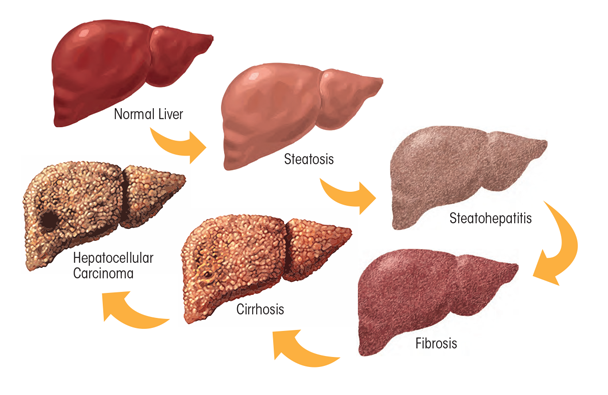Alcohol Induced Liver Diseases
Who is at risk of Alcohol-Induced Liver Disease?
Key Messages
- Alcohol-induced liver disease can occur in any one who drinks alcohol in excess.
- This disease advances in 3 stages:
- Alcoholic fatty liver
- Alcoholic hepatitis
- Alcoholic cirrhosis
- At each stage, some people are able to slow or stop the disease IF they stop drinking alcohol completely.
- If a person is diagnosed with this disease and does not stop drinking, the damage done to the liver (and other are as of the body) could lead to death. There is no way to identify exactly when that could happen.

What is Alcohol-Induced Disease?
”Alcohol-induced liver disease” refers to a disease that can cause increasingly more damage to the liver by alcohol use. The type and amount of damage done to the body by alcohol are different for every person. This disease can occur in anyone who drinks “excess” alcohol for long periods of time and in people who heavily drink (binge-drink) large amounts of alcohol over a shorter period of time.

What does "excess alcohol" mean?
"Excess alcohol" is a different amount for each person. Several factors influence this, including your gender (sex); height and weight; the genes you inherited from your parents (heredity); and whether you have any other causes of liver disease, such as viral hepatitis.
General guidelines from the National Institute of Health define“ at-risk drinking”—the level of alcohol use that puts a person at greatest risk for alcohol-related health problems—as:
- Women: More than 7 standard drinks* per week or more than 2 to 3 drinks per day
- Men: More than 14 drinks per week or more than 4 drinks per day
*A standard drink is a 12-ounce (oz.) beer,a 5-oz.glass of wine,or 1.5oz. of“hard”liquor.
This material describes:
- The stages of alcohol-induced liver disease
- Typical symptoms
- Tests done to diagnose the disease
- Treatment options
If you have questions about your condition or after reading this information, talk with your health care provider.
What is the Liver and What Does It Do?
To understand alcohol-induced liver disease, it may help to know how a normal liver works.
At a weight of about 3 pounds, the liver is the largest solid organ in the body. (SeeFigure1.) Everything you eat, drink, breathe, and absorb through your skin eventually reaches your liver. To be healthy, you need a healthy liver.
Good liver function is needed to:
- Make bile, which helps your body digest food and absorb nutrients
- Store sugar (glucose), which is your source for energy
- Help control your metabolism
- Make proteins, which help build muscles
- Clot blood
- Remove waste
- Break down toxic chemicals
- Filter medications to boost effectiveness
Stages of Alcoholic Liver Disease
The type and amount of damage done to the body by alcohol is different for every person. This disease damages the liver in different ways as it becomes worse overtime. (SeeFigure2.) Descriptions for the 3 stages of liver disease follow.
1. Alcoholic fatty liver
Alcohol-induced liver disease can be diagnosed at the earliest stage—when liver cells are fattened (enlarged) with fat deposits. This can result from daily alcohol use or from repeated binge drinking. If drinking is stopped at this stage and there are no other medical problems, fatty liver usually can be reversed.
2. Alcoholic hepatitis
Alcoholic hepatitis is a serious, but reversible, inflammation (irritation) of the liver caused by drinking alcohol. If a person with alcoholic hepatitis stops drinking, the liver’s inflammation may go down. This condition does not affect all heavy drinkers. There as on for this is not known. Alcoholic hepatitis is not related to viral hepatitis, which is caused by viruses such as hepatitis C.
3. Alcoholic cirrhosis
Alcoholic cirrhosis is the result of long –time inflammation of the liver caused by continual alcohol abuse. When the liver is inflamed for a longtime, scar tissue permanently replaces normal tissue. The scar tissue interferes with normal blood flow, which makes it more and more difficult for the liver to do its job and help keep the body working. Usually, once cirrhosis develops, it cannot be reversed. At this stage, the disease is not treated easily and could lead to liver failure. In addition, individuals who have alcoholic cirrhosis are at risk to develop liver cancer. The most important thing you can do to help avoid the potentially fatal advancement of cirrhosis is to completely stop drinking alcohol.


